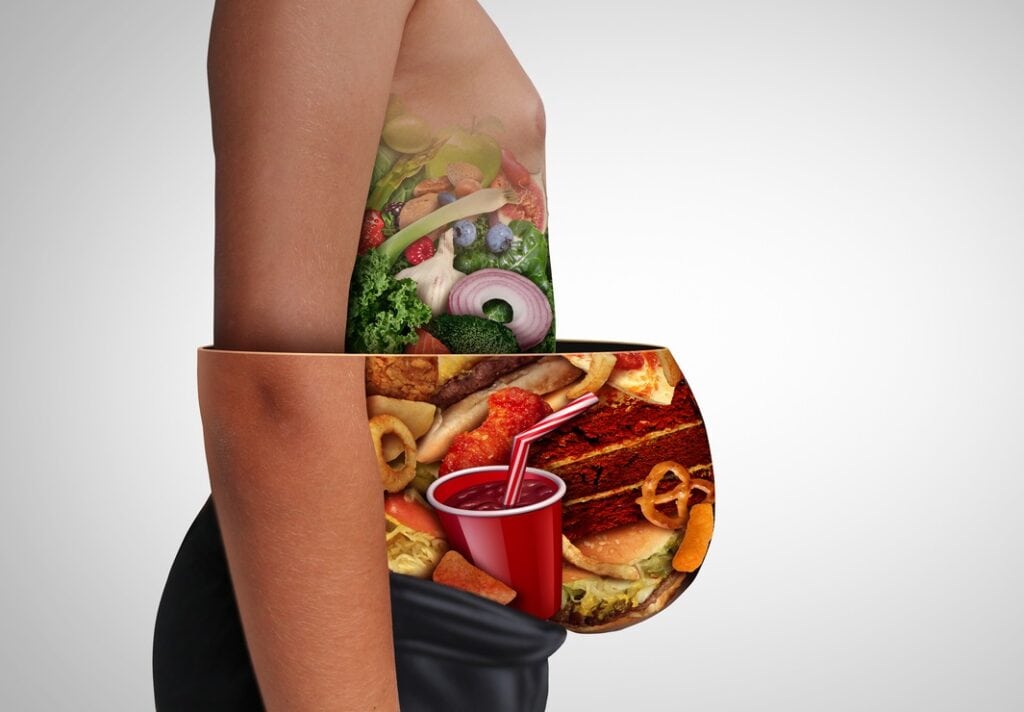Once upon a time in America, families sat down at the table to eat together. Their meals were home-cooked, prepared with real, whole foods, and often locally harvested or sourced. They spoke of things like “three squares” and “supper time,” and they didn’t need to use the word “homemade” because everything was. In fact, most people rarely snacked or dined in restaurants. Sundays were a time to gather as a family or community without being distracted by screens or other competing interests. When we look at photographs from bygone decades, we see a shockingly slimmer population.
Coming together around a communal table continues to be a time-honored tradition in many cultures even today. Even today, if you travel to certain parts of Europe, Asia, or Africa, you’ll be sure to see this common ritual taking place. However, in America most of us no longer savor our meals—and our metabolic and mental health is suffering for it.
Let’s look at some troubling statistics on weight, diabetes, and mental health in American adults. Slightly more than 30 percent are classified as overweight, and 42 percent are obese. Roughly 38 percent have prediabetes, and just over 11 percent have diabetes—with the vast majority falling into the type 2 category. (Many more have insulin resistance, the precursor to type 2 diabetes.) And at least 20 percent of us are suffering from some type of mental health condition. All of these statistics predate Covid and have surely increased since then.
A plethora of reasons are behind these alarming trends—most notably the preponderance of ultra-processed foods that dysregulate metabolic functioning. Other culprits include constant snacking, increasingly sedentary lifestyles, polypharmacy, and an addiction to screens paired with a disconnection from Nature. We mindlessly multitask through every meal, consuming while working, driving, scrolling, watching. In my private practice, I call it “DWE,” or “doin’ while eatin,’” and plenty of my new clients admit to it. But of course there’s also drive by eating—grabbing yet another handful of something while en route to somewhere. No dining chair in sight. No mindfulness to be found.
Let’s contrast American culture with that of France, a country known for its love of food and tableside pleasures. By and large, the French aren’t large, but they spend beaucoup time eating and talking about food. There’s a great question the French like to ask of foreign folk:
A Frenchman enquires, “Do you know when zee French discuss le diner?”
“Non,” replies the uninitiated (non-French) person.
Cue the proud, telling smile: “While we are eating zee lunch!”
A 2015 survey from the Bureau of Labor and Statistics showed that Americans spend just over an hour at the table each day. By contrast, the French spend twice as long as us—over two hours per day. They sit because they enjoy food, conversation, and the joie de vivre this mélange of pleasures brings to their lives. They also delight in the experience of setting a mindful table, oftentimes simple, but always proper. Compare that with eating out of a box or package on the go.
The French also prioritize paying for high-quality food. When it comes to how much money each country spends on food, America comes in last. That’s right—we spend less of our household budget on food than any other nation (just 6.5 percent, a historical low). The French spend double that amount, at 13 percent. This is a reflection of our priorities and our harried lifestyles, and it has resulted in our metabolic and mental health dysfunction.
In France, culinary education starts early, beginning with real, whole puréed first foods. Parents, teachers, and citizens are united in their shared duty to teach children how to appreciate food with all of their senses. This is something I witnessed personally when I lived in Paris. At a produce stand, I saw a class of young school children being instructed by their teacher and the purveyor on how to select the perfect peach. French schools create custom menus, and chefs cook actual food. In an episode of Parts Unknown, the late Anthony Bourdain dines with famed chef Daniel Boulud at an elementary school in Lyon, and it’s wonderfully entertaining.
American schools, on the other hand, feature a rotating reel of ultra-processed pizza, tacos, and hot dogs, all served as quickly as possible in a raucous cafeteria. The French insist that children sit down to eat multiple-course meals, and they teach them a concept foreign to many American children: table manners.
Most French people do not overeat nor overdrink, but they know how to savor their food—not as some sort of reward or special occasion but as a cherished daily ritual. It is simply part of their lifestyle. They put thought and time into preparing meals, then sit down without distraction to really enjoy them, often with good conversation nudged along by wine. Even simple meals are served in courses. (Want a terrific trick for getting a hungry child to eat his veggies? Serve them as a first course, with plenty of olive oil or butter.)
When it comes to achieving vitality and reversing chronic lifestyle conditions, it is crucial to focus on a diet of real, whole, nutrient-rich foods. This is the what and why of the equation—but let’s not forget the how: taking meals while fully present and seated at a table. Enjoy your experiences with food by focusing on your senses or communing with others. You really are what (and how) you eat!
Images from iStock/Zanuck (main), wildpixel (person with food in their stomach), monkeybusinessimages (woman and kids).


